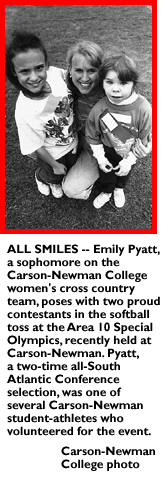
National Collegiate Athletic Association |
The NCAA News - Briefly in the NewsJune 9, 1997
Networks show some team playNormally, you associate a handoff with football, but on May 31 the term worked for baseball.
In what was believed to be a first, CBS transferred coverage of a College World Series game between the University of Miami (Florida) and the University of California, Los Angeles, to ESPN after 12 innings of play. CBS had to make room for its prime-time programming, and the cable network -- which covers all CWS games not carried by CBS -- had the resources available to pick up where the over-the-air network left off. They are competing networks, so the spirit of cooperation is worth noting. The CBS telecast began at 2 p.m. and signed off at 6:30 with the game tied, 3-3, heading into the 12th inning. ESPN picked up the coverage about five minutes later and finished up with Miami's 7-3 victory. Dennis L. Poppe, NCAA director of championships, told the Omaha World-Herald that viewers can thank coordinating producers Tim Scanlan of ESPN and Bob Dekas of CBS for making the transition possible. "ESPN could have very easily said it's not their job, but they said they'd do it," Poppe said. "It was very professional. There was a lot of integrity and effort on their part to do what they thought was right." Friendly reminderJust to make absolutely certain that everybody is clear on this, Division I no longer uses a convention to approve its legislation. Several media reports from conference meetings -- some in major newspapers -- have indicated that Division I legislative proposals will be considered at the 1998 Convention or at a newly created Division I convention. For the record: Effective August 1, all Division I business will be conducted through the conference-representation process that was approved at the 1996 and 1997 Conventions. The Division I Board of Directors, which will meet for the first time in August, will be the ultimate legislative authority for the division. Division-wide votes are possible, but only as part of the override process. Divisions II and III will continue to legislate using the Convention process. Rights issueYou know that scholars have explored almost all angles on First Amendment issues when they examine how they relate to the excessive celebration rule in NCAA football. The most recent issue of the Seton Hall Journal of Sport Law features the following article: "The NCAA Celebration Rule: A First-Amendment Analysis." It is a 30-page study of whether free-speech rights are affected by the NCAA rule that prohibits football players from calling undue attention to themselves after a good play. The conclusion? "Redrafting the celebration rule would benefit not only the NCAA, but also coaches, players and fans. College football is an emotional game and, unlike professional football, the only payment that the student-athletes receive is the applause of fans and an opportunity to celebrate with teammates." Can you top this?Sports information directors at three member institutions seek answers to the following (Nos. 2 and 3 may want to get in touch with one another):
-- Compiled by David Pickle
Answers to the following questions appeared in May issues of The NCAA News. How many can you answer?
1. According to the 1997 NCAA gender-equity survey, what percentage of student-athletes at Division I-A institutions are women? (a) 21 percent; (b) 24 percent; (c) 29 percent; (d) 34 percent.
2. What percentage of operating expenses at Division I-A institutions is attributable to women's athletics? (a) 21 percent; (b) 24 percent; (c) 29 percent; (d) 34 percent.
3. Which school beat top-ranked University of California, Los Angeles, twice in one week en route the winning the National Collegiate Men's Volleyball Championship? (a) Pennsylvania State University; (b) Stanford University; (c) Ball State University; (d) Pepperdine University.
4. Approximately what portion of the nation's high schools have 48H forms on file with the NCAA Initial-Eligibility Clearinghouse? (a) one-third; (b) one-half; (c) two-thirds; (d) three-quarters.
5. According to the Sporting Goods Manufacturing Association, how many people play soccer in the United States? (a) 10.7 million; (b) 16.8 million; (c) 18.1 million; (d) 20.2 million.
6. Which of the new Division I cabinets became the first cabinet in the new governance structure to meet? (a) Academics/Eligibility/Compliance Cabinet; (b) Business/Finance Cabinet; (c) Championships/Competition Cabinet; (d) Strategic Planning Cabinet.
7. How many states currently have some type of law regulating the activities of sports agents and their involvement with intercollegiate student-athletes? (a) 15; (b) 21; (c) 26; (d) 34.
8. Which school has won three straight National Collegiate Women's Lacrosse Championship titles? (a) University of Maryland, College Park; (b) University of North Carolina, Chapel Hill; (c) University of Massachusetts, Amherst; (d) Bloomsburg University of Pennsylvania.
1 - d; 2 - a; 3 - b; 4 - d; 5 - c; 6 - b; 7 - c; 8 - a.
|
 Later this month, Indiana will conduct a ceremony in which it will provide varsity letters to women who participated on Hoosier varsity athletics teams from the 1960s through 1977.
Later this month, Indiana will conduct a ceremony in which it will provide varsity letters to women who participated on Hoosier varsity athletics teams from the 1960s through 1977.